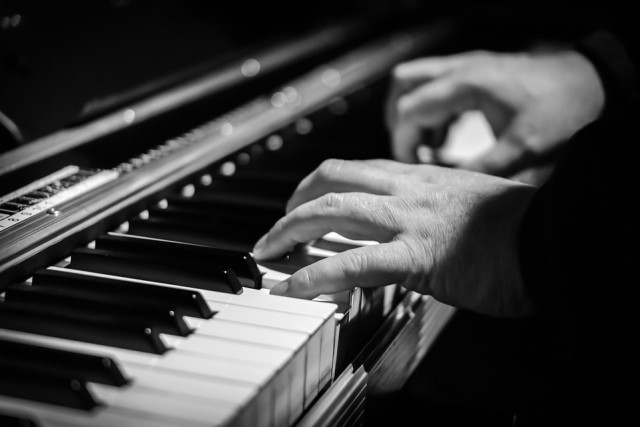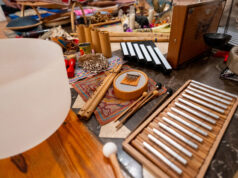The piano has proven to be one of the most significant instruments in modern music because of its ability to produce a wide variety of sounds and textures. The earliest keyboard instruments were the clavichord and harpsichord, appearing in 14th century Europe. Innovations led to the first pianos, which were built in Italy around 1700. Since that time, the piano has grown in size and popularity to become one of the most commonly used instruments in modern music. In this article we see how the piano has been used for creative and cultural expression in various places across the world. The approaches to the instrument here are vastly different and each produces a unique and satisfying signature. We hope that you discover something new about piano music, its connection to history, and possible techniques for the instrument if you are a performer. At the very least, we hope that find some new music to enjoy. All contexts aside, this is simply really gorgeous music.
Watch the full playlist (immediately below) and read more info about each artist further down in this article.
Asia
Chinese Music Piano Xinjiang Dance No. 1 Performed by Zhou Guangren Ding Shan De
Ding Shan De was a Chinese composer (November 12, 1911 – December 8, 1995) who grew up playing traditional Chinese folk instruments. He later moved to piano and eventually studied in conservatory in Europe, but never lost a love for his homeland and culture. After returning to China, he worked at the Shanghai Conservatory of Music as a professor. From 1966 through 1973 during the “Cultural Revolution” against Western influence many of his compositions were burned and he was forced to sweep the gardens daily instead of teaching music. He witnessed ‘No Mozart: Forbidden’ signs being put up at the conservatory, where nine of China’s most accomplished musicians then committed suicide. After the dismantling of Maosist policy, he witnessed the subsequent revival of interest in Western classical music in addition to traditional Chinese folk music.
Ding Shan De was clearly a versatile composer and human being who had a deep understanding of both Western and Chinese music. Here is a classical piano composition that contains seamlessly integrated elements from Chinese folk music. It reminds me of the pieces written by modern impressionistic composers like Debussy that were influenced by Javanese music, yet the sound is identifiably Chinese. Every time I listen to it, I find I like it more and find new things to appreciate that I hadn’t heard before. Since it is a rarely heard style, it may take some repeated listening to adjust to. It is absolutely worthwhile.
Utsay Lal – Raga Piano
Raga is a melodic and improvisational framework used in classical music from India, Nepal, Bangladesh, and Pakistan. A raga is essentially a set of particular notes that are selected along with a style that dictates the order in which those notes and its associated phrases are played. Ragas reflect moods, seasons, times of day, and elements of nature. Raga is traditionally played on sitar, bansuri flute, sarod and is also utilized in vocal performances.
The harmonium is a small keyboard instrument based off of the Western pump organ and is found in modern performances of Indian classical music. Although it has wide acceptance today, its history is somewhat of a controversial. Cultural purists, some of whom were associated with nationalist movements for India, believed the harmonium should not be played because of its Western roots, and thus by its nature cannot produce the sounds required for a proper performance. Out of the 22 notes found in Indian classical music, the piano and harmonium have only 12. In other cases, the harmonium has been a welcome addition bringing its own advantages such as built in drones, fast learning curve for beginners, and ability to easily support group singing contexts. The piano being one of the iconic symbols of Western music falls under similar considerations. Contrast its markedly reduced availability and portability to the harmonium, and it is no wonder that it’s rarely heard in the context of Indian classical music.
Utsav Lal is one of the main proponents today for playing piano in Indian classical music. Though he was not the first to make the fusion, he is certainly the one who is cultivating its unique sonic possibilities and bringing it widespread recognition. His playing has found international acclaim and he has rightfully been bestowed with the title “Raga Pianist”. With knowledge, depth, and sincerity, his playing evokes the feelings of traditional raga music with new dimensions afforded by the sounds of the piano.
http://www.indianragapianist.com/
Caribbean
Chucho Valdés – Mambo Influenciado
Jesús Valdés Rodríguez, known as “Chucho Valdés” is a Cuban pianist, bandleader, composer and arranger. He is most well known for his Afro-Cuban jazz group Irakere, which he founded in 1973. He belongs to a deeply musical family. In 1997 he left the group for a short time and his son Chuchito took over the piano chair. His father Bebo Valdés was an influential Cuban pianist and band leader central to the golden age of Cuban music.
Jazz groups in Cuba formed in the 1920s. Developments came both in Havanna and New York. However, the complete modern integration of all the elements of Afro-Cuban music came later in Cuba with the primary force being the group Irakere.
The rhythm and swing are infectious in this recording. This is music that is for dancing or for sitting and listening. It contains many of the elements of much older Cuban music, namely the mambo, yet the influences of modern jazz are clear. At times, especially in the bass and drums you can almost hear them about to go into a traditional jazz swing feel, yet the Cuban rhythms stay intact and the beat continues. This is in incredible juxtaposition and collage of sound. It is like a Picasso painting.
North America
Harry ‘The Hipster’ Gibson – 4F Ferdinand (1944)
This recording features the boogie woogie blues piano and vocal style. Piano music of this style has a long and diverse history that spans decades and miles across the United States. The main progenitors of boogie woogie piano were Meade Lux Lewis, Albert Ammons, and Pete Johnson. Harry’s singing style here was heavily influenced by fellow New York city native Fats Waller, who eventually hired him to fill in at the top clubs in Harlem after hearing him.
I think Harry is notable because here we see a white artist for the first time performing convincingly what was an exclusively African American style of singing and playing. Additionally, his performances show elements of Rock and Roll a decade before it took off in the 50s. The unrestrained wild freedom of expression, and a stronger focus on the driving ‘rock beat’ can be heard in many of his recordings. When white musicians began to perform Rock and Roll, teenagers of the 50s started to show interest in African American music. This opened the door to an increased consciousness in America with respect to racial harmony and questioning the status quo.
I find his performances engaging and his piano playing to be exceptional. However it is the ease with which he sings, plays, makes an assortment of comical facial expressions, and doesn’t drop a beat that makes his performances truly entertaining. He is also noted for coining the term ‘hipster’, of which he deemed himself to be the first.
Herbie Hancock – Canteloupe Island
The renowned Cuban percussionist Mongo Santamaria at one point was having a conversation with some jazz musicians about how he does not understand the link between Afro-Cuban and African American music. It was then that Herbie began to play “Watermelon man”, and when Mongo started to join them on congas, the answer to the question became clear. Herbie incorporated rhythms across many cultures to create a funky blend that catches anyone’s ear who hears it.
“Canteloupe Island” is another of Herbie’s compositions that is written in a similar style. This recording was taken from a VHS recording of a TV broadcast concert from the mid 90s. To me, this concise solo displays all the elements of Herbie’s playing that make it great – technical ability, soul, and his unique funky sound. He creates a vast colorful blend of harmonies and rhythms as he reaches higher and higher until finally bringing back the catchy melody. The hip hop group US3 sampled the original studio recording and turned it into a track they called “Canteloop” which later became the first Blue Note record to achieve platinum status.
Africa
Ray Lema – Atan’dele
Ray Lema was born in the former Kingdom of Kongo, in what is today called the Democratic Republic of Congo. He began his musical journey while in seminary studying to become a priest. After his natural aptitude for music was realized, he was encouraged to perform the services of organ and piano accompaniment for mass. He left the seminary for university, and eventually left university to transition back to music. In 1974, he was appointed music director of the National Ballet of Zaire, which led him on a search for the greatest musicians in the country to represent their rich culture and to accompany the dancers of the ballet. From there his success continued and he now performs internationally in a variety of musical settings.
Ray’s piano playing and singing here is sweet, simple, and heart felt. I learned the meaning of his words from the comments written in French by Congolese listeners who understood his lyrics.
“”Atan’dele” is a term in Lingala which is difficult to translate word for word. It essentially means ‘A day will come.’ He expressed the hope of a better Africa where good will rise and accomplices of neo-colonialists will be judged and punished.”
Coming from a war torn country shattered by colonialism, he sings that sooner or later change will come. When I listen to his voice, I hear a statement of truth and trust in the future that despite a past of devastating tragedy, greatness can still arise.
The syncopated piano here is very unique. The seemingly simple harmony is made subtle in its relaxed and pensive interlocking rhythms.
Ahmed Fofana – Mandingue Piano Solo
Ahmed Fofana was born in the Ivory Coast to Malian parents. He comes from a family of griots, the traditional West African historian, storyteller, poet and musician. The balafon is a kind of wooden xylophone percussion instrument which plays melodic music. According to history narrated by the griots, it has been played since at least the 12th century, originating with the rise of the Mali empire.
In some settings, the balafon is played solo, where as others it is used in larger drum ensembles. The balafon is similar in layout to the piano, however the technique of performance is very different. This is one of the only recordings I have heard featuring a griot balafon player translating the style of the instrument to piano. This is a true rarity. Enjoy!
Europe
Ignacy Jan Pederewski – Chopin Waltz in C Sharp Minor
Frederick Chopin’s compositions are primarily solo piano or works based around it. Commonly known by his title the “poet of the piano”, he brought a new lyricism and expressiveness to the Romantic era. Chopin’s nationalism and the love he felt for his homeland Poland came through in many nostalgic melodies throughout his work.
Ignacy Jan Paderewski was a unique figure in Poland’s history. His career as a concert pianist began in 1889, and soon his reputation took off to achieve superstar status. He was equally passionate about his homeland Poland, and during his time on tour he was able to form lasting relationships with the leading statesmen of Europe and America. With his dynamic personality and natural ability for oration and linguistics (he spoke 7 languages fluently), he was able to use his popularity to contribute greatly to the restoration of Poland’s independence. He served as the first prime minister of the newly independent Poland before returning to a career as a concert musician.
I’ve chosen Paderewski’s 1917 recording of Chopin’s famous “Waltz in C Sharp Minor”, because to me it is otherworldly. He was one of the last great Romantic pianists, and it is extraordinary to hear his playing captured on such an early recording. In addition, the traditional folk music of Poland comes through in this composition, and Paderewski with his intimate involvement in the nations history seems well suited to interpret it.
South America
Arminda Canteros, La Cumparsita
Tango has become a symbol of Argentinian and Uruguayan culture to the world. Its vibrant pulse inherits influence from the traditions of European immigrants, indigenous South Americans, and the descendants of African slaves. The local folklore along with the stories of the working class immigrant population come through in its themes of economic struggle, lost romance, masculinity, alluring women, and city life.
In Tango, the music was typically played by men, where an attitude of machismo was common. Arminda Canteros was an Argenitnian concert pianist who would play tangos for her father who did not care for the classical music she typically performed. She innovated her own style of solo tango piano music and played on a weekly radio program in the 30s and 40s. She had to take on the pseudonym ‘Juancho’ while on the air to conceal the fact that she was a woman. The public not realizing this remained fascinated by her interpretations. This is a recording of her playing the definitive tango piece, “La Cumparsita”.
Elis Regina and César Mariano – Águas de Março
Antônio Carlos Jobim was one of the main innovators of the ‘bossa nova’ style. He is most well known for “The Girl from Ipanima”, and has been called the George Gershwin of Brasil by virtue of his compositional output. He was influenced by modern French classical composers Debussy and Ravel, American cool jazz, and the ‘samba’ rhythm which derives its main roots from the music and dance of Cape Verde.
This session features Elis Regina on vocals and César Camargo Mariano on piano. Elis’s gorgeous singing and how it is effortlessly supported by the musicians creates a beautiful effect. César has also composed and performed scores of instrumental piano music in a style which is clearly and uniquely Brazilian. Additionally, he has worked as arranger, producer and musical director on countless albums, including the historic 1973 album “Elis e Tom”, featuring Jobim on vocals. He is a prolific pianist and visionary who continues to perform today.
























http://www.pianoraag.com “How to Play Indian Sitar Raags on a Piano” – new book for adventurous pianists